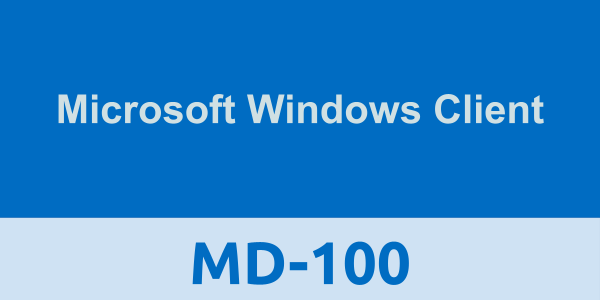This exam measures your ability to accomplish the following technical tasks: install and configure Windows; configure and manage connectivity and storage; maintain Windows; and protect devices and data.
Candidates for this exam are IT professionals who have subject matter expertise in installing, configuring, and maintaining Microsoft Windows clients within a domain infrastructure. Responsibilities include protecting and maintaining the reliability of the Windows device and the data stored on the device. Candidates for this exam administer Windows clients in a Microsoft Azure Active Directory (Azure AD), part of Microsoft Entra environment. Candidates for this exam may collaborate with the Microsoft 365 enterprise administrator, the Microsoft 365 security administrator, and Windows Server administrators to implement a modern desktop and device strategy that meets the business needs of an organization.
Candidates for this exam must be familiar with device management, client computer networking, policy-based management, and cloud-based solutions.
Microsoft Windows Client Exam Summary:
| Exam Name | Microsoft 365 Certified - Modern Desktop Administrator Associate |
| Exam Code | MD-100 |
| Exam Price | $165 (USD) |
| Exam Price | 120 mins |
| Number of Questions | 40-60 |
| Passing Score | 700 / 1000 |
| Books / Training | Course MD-100T00: Windows Client |
| Sample Questions | Microsoft Windows Client Sample Questions |
| Practice Exam | Microsoft MD-100 Certification Practice Exam |
Microsoft MD-100 Exam Syllabus Topics:
| Topic | Details |
| Install and configure Windows (20-25%) | |
| Install Windows client | - Select the appropriate Windows edition - Prepare hardware for installation - Perform a manual clean installation - Plan and implement an upgrade from a previous version of Windows - Customize a Windows client installation by using the Windows ADK - Configure activation and troubleshoot activation issues |
| Manage and use Hyper-V on Windows client | - Create and configure virtual machines by using Hyper-V - Manage virtual hard drives - Manage virtual networks - Configure Hyper-V settings - Configure and manage checkpoints - Enable and use Windows Sandbox |
| Configure Windows settings | - Configure system settings - Manage user interface in Windows 10 and Windows 11 - Configure Microsoft Edge - Configure language and region - Configure and troubleshoot connections to printers and other devices - Configure Windows client by using provisioning packages - Configure startup options - Configure and manage services - Install and configure optional features |
| Configure and manage connectivity and storage (15-20%) | |
| Configure networking and access | - Configure client IP settings - Configure mobile networking - Configure VPN client by using built-in tools or Connection Manager Administration Kit (CMAK) - Configure and manage certificates on client devices - Troubleshoot client connectivity |
| Configure and manage storage | - Configure local storage - Configure OneDrive on Windows client - Optimize local drives by using Disk cleanup or Storage Sense - Configure file and folder permissions |
| Maintain Windows (30-35%) | |
| Perform system and data recovery | - Troubleshoot boot and startup processes - Recover Windows client - Recover files - Create and manage restore points - Restore from restore points |
| Manage Windows updates | - Configure updates - Configure Windows delivery optimization - Control updates by using group policy settings - Configure updates by using Windows Update for Business - Troubleshoot updates |
| Configure remote management | - Configure Remote Desktop - Configure Windows Admin Center - Configure PowerShell remoting and Windows Remote Management - Configure remote assistance tools including Remote Assist and Quick Assist |
| Monitor and manage Windows | - Configure and analyze event logs - Monitor and manage performance and reliability - Configure scheduled tasks - Manage registry |
| Protect devices and data (25-30%) | |
| Manage users, groups, and computer objects | - Manage local users - Manage local user profiles - Manage local groups - Manage Microsoft accounts on Windows client - Enable users and groups from Active Directory to access Windows client - Join computers to Active Directory - Configure sign-in options - Manage credentials by using Credential Manager - Configure user account control (UAC) - Implement and manage Microsoft Local Administrator Password Solution (LAPS) |
| Configure and manage local and group policies | - Troubleshoot local policies and domain group policies on Windows client - Configure and manage local and group policies, including security policy, user rights assignment, and audit policy - Configure Windows client settings by using group policy |
| Manage security settings on Windows client | - Implement Bitlocker - Configure and manage Windows client firewall - Manage virus and threat protection - Manage application and browser control settings |





0 comments:
Post a Comment